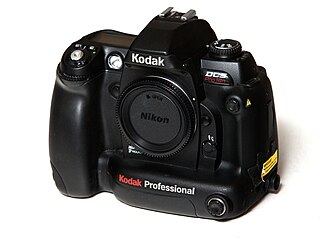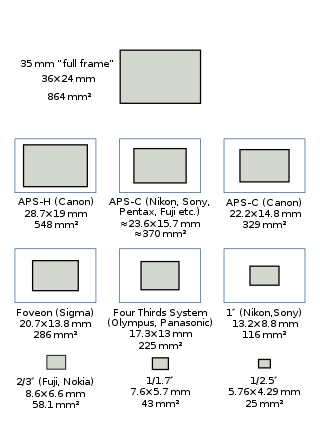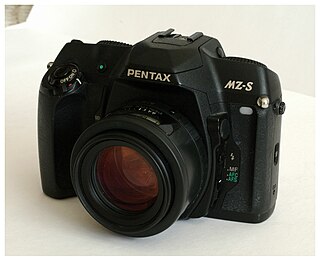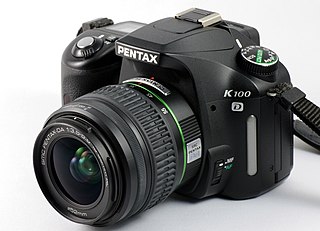Related Research Articles

Pentax Corporation was a Japanese camera and optical equipment manufacturer, and currently, it exists as the Pentax Life Care Business Division of Hoya's medical endoscope business, as well as the digital camera brand of Ricoh Imaging, a subsidiary of Ricoh.

A digital single-lens reflex camera is a digital camera that combines the optics and mechanisms of a single-lens reflex camera with a solid-state image sensor and digitally records the images from the sensor.

The Nikon D1 is a digital single-lens reflex camera (DSLR) that was made by Nikon Corporation introduced on June 15, 1999. It features a 2.7-megapixel image sensor, 4.5-frames-per-second continuous shooting, and accepts the full range of Nikon F-mount lenses. The camera body strongly resembles the F5 and has the same general layout of controls, allowing users of Nikon film SLR cameras to quickly become proficient in using the camera. Autofocus speed on the D1 series bodies is extremely fast, even with "screw-driven" AF lenses.

The Kodak Professional DCS Pro 14n is a professional Nikon F80 based F-mount digital SLR produced by Eastman Kodak. It was announced at the photographic trade show photokina in Germany during September 2002; production examples became available in May 2003.
The Contax N Digital was a six-megapixel digital SLR camera produced by Contax in Japan. The camera was announced in late 2000, and began to be sold in spring 2002, after several delays. The camera received mixed reviews from the press, and was withdrawn from the market within a year of its introduction.

A full-frame DSLR is a digital single-lens reflex camera (DSLR) with a 35 mm image sensor format. Historically, 35 mm was one of the standard film formats, alongside larger ones, such as medium format and large format. The full-frame DSLR is in contrast to full-frame mirrorless interchangeable-lens cameras, and DSLR and mirrorless cameras with smaller sensors, much smaller than a full 35 mm frame. Many digital cameras, both compact and SLR models, use a smaller-than-35 mm frame as it is easier and cheaper to manufacture imaging sensors at a smaller size. Historically, the earliest digital SLR models, such as the Nikon NASA F4 or Kodak DCS 100, also used a smaller sensor.

The Olympus E-10 is a digital single-lens reflex camera with a 4.0-megapixel CCD image sensor that was introduced in 2000. Unlike most digital SLRs the camera is not a system camera – its lens is fixed to the body. It has a TTL optical viewfinder, and a 4× optical zoom lens with lens aperture f/2–2.4. Instead of a moving (reflex) mirror a beam splitting fixed (non-reflex) prism is used to split the image between the optical viewfinder and CCD. Thus it was possible to have a live view on the LCD and in parallel see the image in the TTL viewfinder.

The Sigma SD14 is a digital single-lens reflex camera produced by the Sigma Corporation of Japan. It is fitted with a Sigma SA mount which takes Sigma SA lenses.

The Pentax K10D and similar Samsung GX-10 are 10.2-megapixel digital single-lens reflex cameras launched in late 2006. They were developed in a collaboration between Pentax of Japan and Samsung of South Korea.

The Pentax MZ-S is a 35mm single-lens reflex camera from Pentax of Japan. It was introduced in 2001 and discontinued in February 2006. It is closely related to the prototype MZ-D Full-frame digital SLR, which never entered production. It was the top-of-the-line model of Pentax's MZ/ZX series and replaced the PZ-1p as the high-end Pentax camera. No camera was produced to replace the MZ-S, making it Pentax's last high-end 35 mm camera. The MZ-S is the last film camera from Pentax that was manufactured in Japan.

The Maxxum 7D, labelled Dynax 7D in Europe/Hong Kong and α-7 Digital in Japan and officially named "DG-7D", is a 6.1 megapixel digital single-lens reflex camera, or DSLR, produced by Konica Minolta. It was the top model of their DSLR range; the Maxxum/Dynax 5D consumer-grade model was the other.

The Pentax K100D and similar Pentax K110D are 6-megapixel digital single-lens reflex cameras, launched in the U.S. on May 22, 2006. The K100D has a maximum resolution of 3008 x 2008, and can also down-sample to 2400 x 1600 and 1536 x 1024. The slowest metered shutter speed is 30 seconds and the fastest shutter is 1/4000 seconds.

The Pentax ME F was an amateur level, interchangeable lens, 35 mm film, single-lens reflex (SLR) camera. It was manufactured by Asahi Optical Co., Ltd. of Japan from November 1981 to 1984. The ME F was a heavily modified version of the Pentax ME-Super, and a member of the Pentax M-series family of SLRs. It was the first mass-produced SLR camera to come with an autofocus system.

This article details lensesfor single-lens reflex and digital single-lens reflex cameras. The emphasis is on modern lenses for 35 mm film SLRs and for "full-frame" DSLRs with sensor sizes less than or equal to 35 mm.

The Canon EOS D2000 is a 2-megapixel digital single-lens reflex camera developed by Kodak on a Canon EOS-1N body. It was released in March 1998. It features a CCD sensor and can shoot at 3.5 frames per second. Many enthusiasts regard the D2000 as Canon's first truly usable Digital SLR. It was released in tandem with the Canon EOS D6000, a 6-megapixel model.

The α900 (DSLR-A900) is a full-frame digital SLR camera, produced by Sony. An early design study of the camera was shown at PMA on 8 March 2007, and a newer prototype announced at PMA 2008 on 31 January 2008. Sony officially introduced the final camera on 9 September 2008 prior to photokina 2008. In October 2011, Sony Japan announced the camera's end of production.
This article discusses the cameras – mainly 35 mm SLRs – manufactured by Pentax Ricoh Imaging Corp. and its predecessors, Pentax Corporation and Asahi Optical Co., Ltd.. Pentax must not be confused with Pentax 6x7 or Pentax 67 which are 120 medium format 6x7cm film cameras.

Pentax lenses were first badged as Takumar. The Takumar branded lenses were well respected for their line of Super Takumar, which designated the high performance coating applied to the lens as well as the optical formulas used to make them. The majority of the industry at the time was still satisfied with the variations of the "plumb" coating process and later some of the two and three layer processes as well. Asahi Pentax soon introduced the Takumar Super-Multi-Coated line of lenses which was a 7 layer process as the industry had just caught up with similar forms of 5 layer multi-coated optics. Eventually Asahi Optical and Pentax slowly shifted much of their lens production under the Pentax name and transitioned some of the successful designs that were first introduced under the Takumar name to use Asahi/Pentax badging as well as beginning to use the "smc" abbreviation. Eventually the Asahi partnership disappeared and the Pentax name became solely used. Pentax lenses saw many feature changes to answer the market, such as: incorporating "Auto-Aperture" with the M42, the light weight and compactness with the 'M' series, Aperture Priority overrides with the 'A' series, and Auto-Focus with the 'F' series. Modern Pentax lenses for digital SLR cameras have seen the elimination of the aperture ring completely as found on Pentax DA and D-FA series lenses. They use the Pentax KAF mount. All of these lenses have an autofocus feature, either operated from the camera body or from an internal SDM motor. Pentax compatible lenses are also made by third-party companies.

The Pentax K-3 is a 24-megapixel Pentax high-end digital single-lens reflex camera with an APS-C sensor, announced on 7 October 2013. The Pentax K-3 is the successor to both the K-5 II and K-5 IIs models, which have a 16-megapixel sensor. The K-5 II had an optical low pass filter or anti-aliasing (AA) filter that can prevent the appearance of moire patterning on the captured image. This filter reduces the sharpness of the image, so Pentax also produced the K-5 IIs which omitted this filter. In the K-3, Pentax obviated the need for providing two separate models by including a selectable AA filter "simulator". This mechanism vibrates the sensor when switched on, slightly blurring the image in a way that replaces the function of the optical AA filter, providing the same benefit as the filter in the K-5 II and other cameras with an optical AA filter. When the AA simulator is disabled, the sensor records a sharper image, as in the K-5 IIs.
The Leica S-System is a medium format digital single lens reflex camera system introduced by Leica Camera in 1996. Beginning with the Leica S1, a prototype top-end studio digital camera unveiled at Photokina 1996. It went into production at the end of 1997.
References
- Tomkins, Michael. PMA 2001 Show: Pentax EI-3000 and unnamed digital SLR - exclusive pics!. Imaging-Resource.com, retrieved on November 21, 2005.
- Dimitrov, Bojidar. MZ-D. Bojidar Dimitrov's Pentax K-Mount Page, retrieved November 21, 2005.
- Pentax prototypes at Photokina, Asahi Optical Historical Club (2000)
- "MR-52" 6Mpixel digital SLR, Asahi Optical Historical Club (2000)